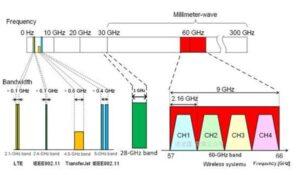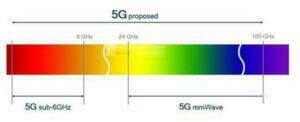[GUIDE] in the 30 years of mobile communication development, millimeter wave has always been an uncultivated wasteland. Laboratories of communication giants such as Qualcomm, Ericsson, Huawei, and ZTE have continuously studied it. Now millimeter wave has been more and more used in life, such as millimeter wave radar technology and 5g technology. In this article, we will introduce the division of millimeter wave spectrum and the analysis of millimeter wave terminal technology test scheme, so as to help you have a further understanding of millimeter wave.
1. Background of millimeter wave generation
With the increasing shortage of spectrum resources, the development and utilization of millimeter wave spectrum resources used in satellite and radar military systems has become the focus of the fifth generation mobile communication technology. Because millimeter wave band has huge space for the development of spectrum resources, it has become the primary choice of massive MIMO communication system. The wavelength of millimeter wave is short. In massive MIMO system, the design of large-scale antenna array can be realized at the base station of the system, so that the millimeter wave application can be combined with beamforming technology, which can effectively improve the antenna gain. However, due to the short wavelength of millimeter wave, in millimeter wave communication, when the transmission signal takes millimeter wave as the carrier, it is easy to be disturbed and attenuated to varying degrees by external noise and other factors.
2. Introduction to millimeter wave
Millimeter-wave: the electromagnetic wave with the wavelength of 1 ~ 10mm is called millimeter-wave, and the corresponding frequency is 30 ~ 300GHZ. It is located in the overlapping wavelength range of microwave and far-infrared wave, so it has the characteristics of both spectrums.

Advantages of millimeter wave:
1) Extremely wide bandwidth. It is generally considered that the frequency range of millimeter wave is 26.5 ~ 300GHZ, and the bandwidth is as high as 273.5ghz. More than 10 times the total bandwidth from DC to microwave. Even if atmospheric absorption is considered, only four main windows can be used when propagating in the atmosphere, but the total bandwidth of these four windows can reach 135ghz, which is five times the sum of the bandwidths of all bands below microwave. Combined with the use of various multiple access multiplexing technologies, it can greatly improve the channel capacity and is suitable for high-speed multimedia transmission services, which is undoubtedly very attractive in today’s tense frequency resources.
2) Narrow beam. Under the same antenna size, the beam of millimeter wave is much narrower than that of microwave. For example, a 12cm antenna has a beam width of 18 degrees at 9.4ghz and only 1.8 degrees at 94GHz. Therefore, small targets closer to each other can be distinguished or the details of the target can be observed more clearly.
3) High reliability and high frequency make it less disturbed, which can better resist the influence of rain weather and provide a stable transmission channel; Compared with laser, the propagation of millimeter wave is much less affected by climate, which can be considered to have all-weather characteristics.
4) Good directivity, millimeter wave is greatly absorbed by various suspended particles in the air, which makes the transmission beam narrow and increases the difficulty of eavesdropping. It is suitable for short-distance point-to-point communication;
5) The wavelength is very short, the required antenna size is very small, and it is easy to integrate a large-scale antenna array in a small space. Compared with microwave, millimeter wave components are much smaller in size. Therefore, the millimeter wave system is easier to miniaturize.
Disadvantages of millimeter wave:
In addition to its advantages, millimeter waves also have a major disadvantage, that is, they are not easy to pass through buildings or obstacles, and can be absorbed by leaves and rain. This is why the 5g network will adopt a small base station to strengthen the traditional cellular tower. In millimeter wave communication system, the spatial selectivity and dispersion of signals are limited by the high free space loss and weak reflection ability of millimeter wave. Due to the configuration of large-scale antenna arrays, it is difficult to ensure the independence between antennas. Therefore, the number of antennas in millimeter wave system is much higher than that of propagation paths.
At the same time, in terms of technology, the technical “defect” of millimeter wave can now become an advantage.
You should know that the higher the frequency band, the lower the size requirements for the receiving antenna. This means that for terminals supporting millimeter wave, the receiving antenna inside the fuselage can be made smaller than before, and for terminals without size limit, more high-frequency antennas can be accommodated in the original technology, so as to obtain a better reception effect.
More importantly, because the propagation distance of millimeter wave itself is shorter than the frequency below 6GHz, its directionality will be more advantageous in the whole propagation path, which will reduce the possibility of interference between millimeter wave signals and improve the propagation accuracy. In addition, due to the short propagation distance of narrow beam itself, the possibility of long-distance interception will become lower, and it also has incomparable advantages in communication security.
Of course, strictly speaking, the so-called millimeter wave refers to the EHF band, which is an electromagnetic wave with a frequency range from 30ghz to 300GHZ. If defined from the wavelength, the electromagnetic wave length of 30ghz is 10mm, while the electromagnetic wave length of 300GHZ is only 1mm. However, according to the playback of the FR2 band, the wavelength of 24.25ghz has exceeded 10mm. Although we call it millimeter wave, many people think it should be classified into the category of centimeter wave.
However, since no organization in the world has issued a clear definition of millimeter wave, it is harmless to count the FR2 band as millimeter wave from the perspective of broad recognition.

3. Millimeter wave spectrum division
In 2015, ITU-R wp5d released IMT In the Research Report of above 6GHz, the attenuation characteristics of radio waves in different frequency bands are studied in detail. Several 5G candidate millimeter wave bands were proposed at the world radiocommunication Conference (wrc-15) in the same year, and the final determination of 5G millimeter wave spectrum will be completed on wrc-19.
Globally, there are only two kinds of 5g deployed frequency bands, one is sub-6ghz, which refers to the frequency band below 6GHz, and the other is millimeter wave.

After years of research and discussion, countries and regions have made progress in the division of millimeter wave spectrum resources. The following will focus on the recent situation of millimeter wave spectrum division in China, the United States and Europe.
China: in June 2017, the Ministry of industry and information technology widely solicited opinions from the society on the use of 24.75-27.5 GHz, 37-42.5 GHz or other millimeter wave bands for 5g systems, and included the millimeter wave band in the scope of 5g test, in order to promote the research of 5G millimeter wave and the R & D and test of millimeter wave products.
United States: as early as 2014, the FCC (Federal Communications Commission) started the allocation of 5G millimeter wave band. In July 2016, it was determined to allocate 27.5-28.35 GHz, 37-38.6 GHz and 38.6-40 GHz as authorized spectrum to 5g, and 64-71 GHz as unauthorized spectrum to 5g.
Europe: in November 2016, rspg (Radio spectrum policy group of the European Commission) released the EU 5g spectrum strategy, determining 24.25-27.5 GHz as the leading band of 5g in Europe and 31.8-33.4 GHz and 40.5-43.5 GHz as the potential band of 5G.
4. 5G oriented millimeter wave network architecture
After the completion of 5G, the powerful data transmission capacity, strong stability, and wide coverage of 5G network have brought many benefits to the era of big data. In some built areas, users can experience the transmission rate of 10m / s or above, so as to provide a guarantee for social development and people through the network. Relevant facts show that for the problem of small LTE coverage, large coverage can be carried out through 5g to deal with this problem. However, in the initial stage of 5g construction, it is necessary to select a suitable address to build the corresponding infrastructure, and at the same time, the maintenance cost is high in the later stage. Therefore, at present, it is still undergoing theoretical tests and has not been really put into use. Therefore, 5G Premier League is developing towards miniaturization and integration. Based on this, the infrastructure can be built into a beautiful form to help the environment. Design and deploy scientifically according to the actual situation of the construction, so as to save the economy.
At the communication level, data and signaling can play different roles. Data is transmitted from one terminal to another through a special channel. Signaling needs to go through various transmissions in the network. At the same time, it may need to be processed in order to play the greatest role in transmission. In the communication system, signaling and data have different transmission channels. After the system is completed, LTE can transport different signaling. The design in the 5G system separates data from signaling, which can deal with the situation that signaling occupies too many resources in LTE, so as to improve the efficiency of transmission.
